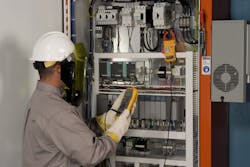Many preventive maintenance measurements aren’t very helpful when taken in isolation. Their real power comes from trending. One of the barriers to trending has traditionally been the problem of getting the data from the field to the system that can produce the trends.
The DMM is the most commonly used instrument for preventive maintenance, so solving the trending issue with DMM measurements is a good first step toward locking down the trending environment that will make the most of those measurements. If you don’t have DMMs with connectivity, consider upgrading. Look for one that lets you upload files without the need for special cords.
For example, let’s say your PMs call for measuring voltages across connections. From a one-time perspective, any small voltage is fine; the actual value doesn’t matter, it just can’t be too big. A small loss across a connection probably doesn’t justify shutting down the system to repair the connection.
But suppose you’re taking measurements quarterly and your system can trend the measurements. If that value is creeping up, then you know you have a deteriorating condition that calls for attention in the near future. The rate of creep upward also informs you how soon you need to address that connection.
Insulation resistance is another area where trended measurements are much more valuable than “single instance” measurements. Always trend these. The trend can tell you when the insulation of a feeder conductor or the insulation on the windings of a critical motor is heading for failure. Today, you can find insulation resistance testers with the same sort of connectivity we just discussed for DMMs. And you can even find them as DMM/insulation resistance tester combination instruments.
About the Author

Mark Lamendola
Mark is an expert in maintenance management, having racked up an impressive track record during his time working in the field. He also has extensive knowledge of, and practical expertise with, the National Electrical Code (NEC). Through his consulting business, he provides articles and training materials on electrical topics, specializing in making difficult subjects easy to understand and focusing on the practical aspects of electrical work.
Prior to starting his own business, Mark served as the Technical Editor on EC&M for six years, worked three years in nuclear maintenance, six years as a contract project engineer/project manager, three years as a systems engineer, and three years in plant maintenance management.
Mark earned an AAS degree from Rock Valley College, a BSEET from Columbia Pacific University, and an MBA from Lake Erie College. He’s also completed several related certifications over the years and even was formerly licensed as a Master Electrician. He is a Senior Member of the IEEE and past Chairman of the Kansas City Chapters of both the IEEE and the IEEE Computer Society. Mark also served as the program director for, a board member of, and webmaster of, the Midwest Chapter of the 7x24 Exchange. He has also held memberships with the following organizations: NETA, NFPA, International Association of Webmasters, and Institute of Certified Professional Managers.
